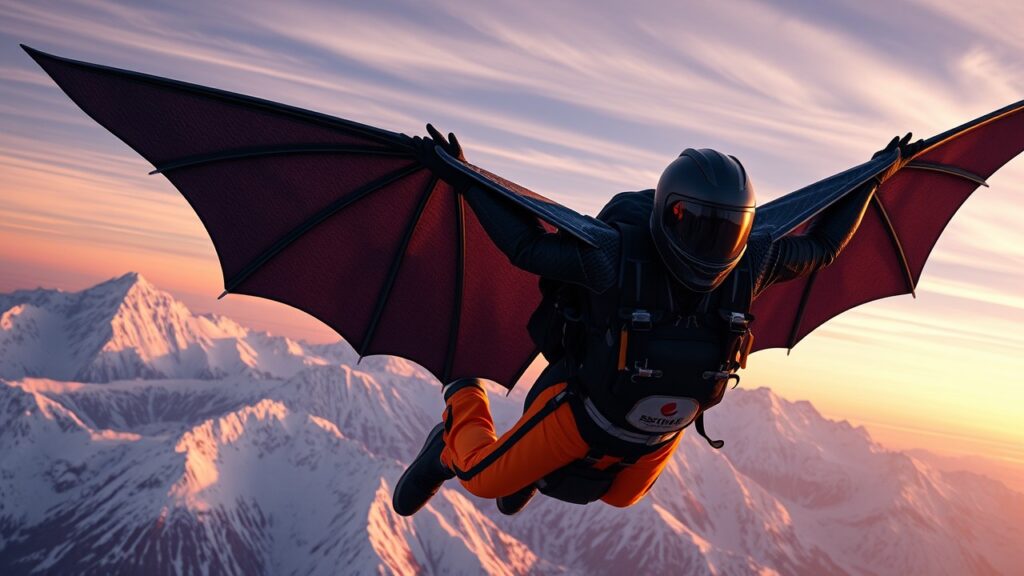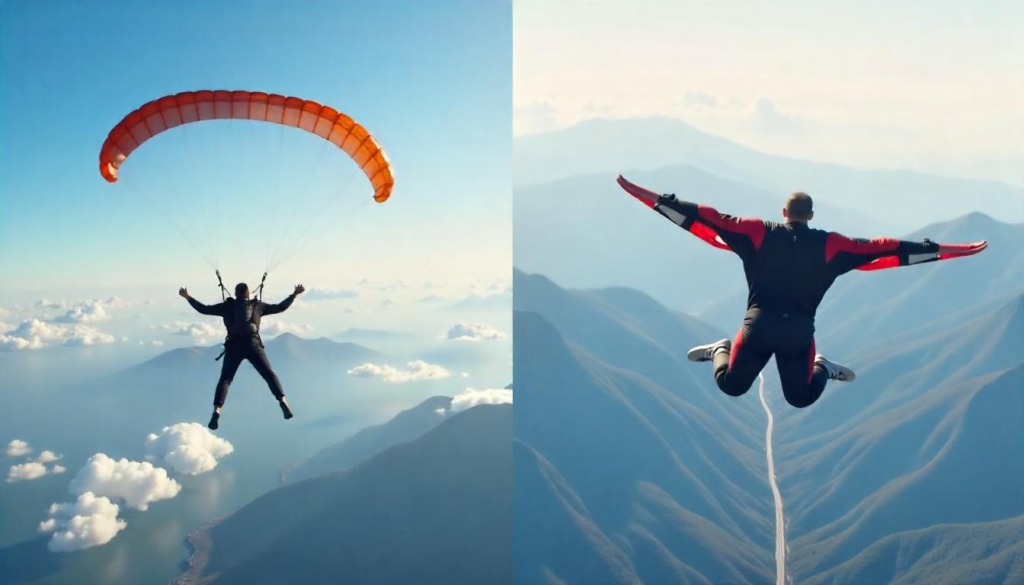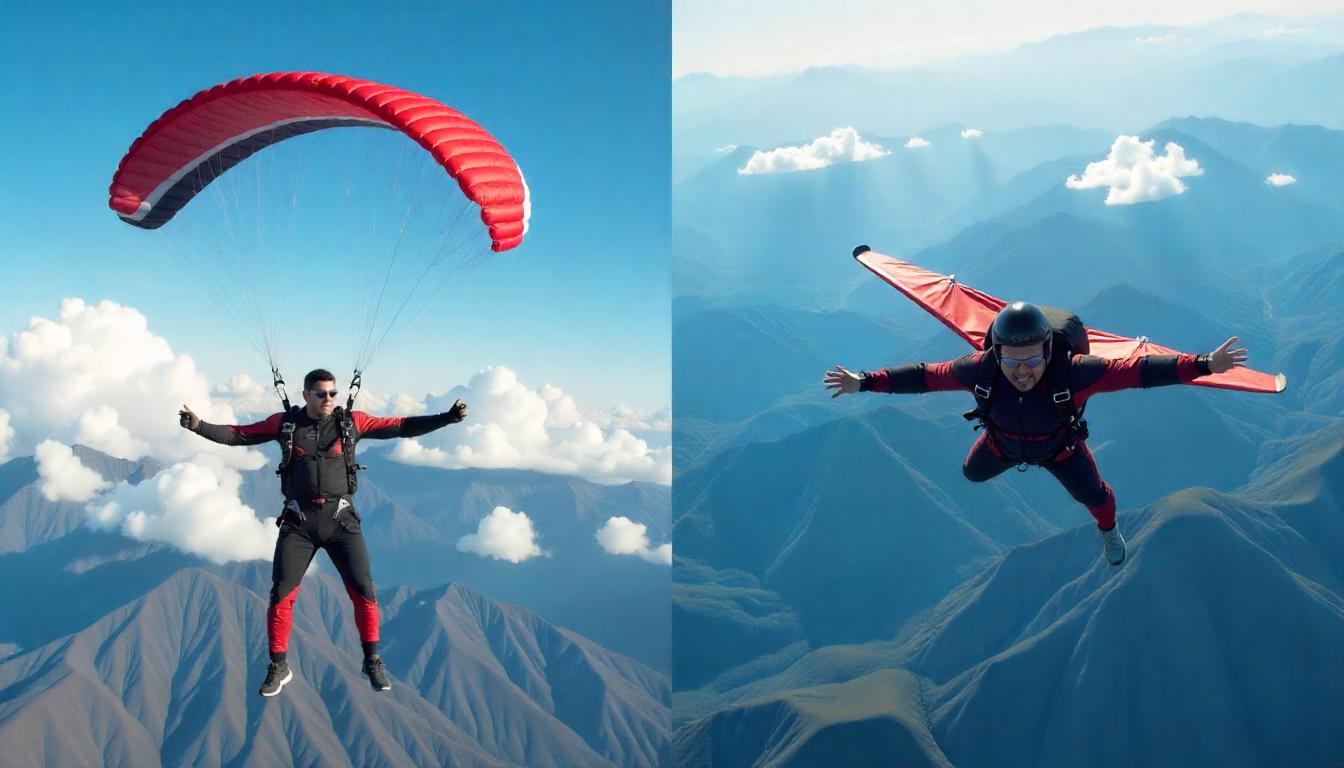When discussing Wingsuit vs. Parachute, it’s important to recognize that they have distinct functions, yet they complement each other beautifully in the world of air sports. Wingsuit flying explained allows pilots to glide through the sky with remarkable agility and precision, almost like flying. The experience of soaring through the air is exhilarating, giving pilots a unique perspective as they navigate through the clouds. On the other hand, parachute skydiving basics play a critical role in ensuring a safe return to the ground. They’re the safety net for all that excitement, providing controlled descents after the thrill of freefall.
Let’s explore how these two flight methods differ and enrich each other. Wingsuit and parachute differences highlight that wingsuits are designed for speed and maneuverability, enabling pilots to perform daring turns and adjustments mid-air. This skill level contributes to the excitement that draws many to the sport. Meanwhile, parachutes are essential for safety. They not only slow down descent but also allow for precision landings, which is key for any adventurous participant looking to make a safe return.
These two activities, when used together, create a richer experience for thrill-seekers. While some might argue that wingsuits alone can offer enough excitement, parachutes add a layer of security that enhances confidence—critical in the debate of wingsuit safety vs parachute safety. The combination encourages enthusiasts to push their limits while knowing they have a reliable means of safely landing. Understanding how wingsuits and parachutes work together can deepen appreciation for the sport and inspire new enthusiasts to give it a try.

Parachute
Main Purpose:
A parachute is a brilliant safety tool carefully crafted to enable a safe fall from the air to the earth by producing drag that successfully breaks the fall. This life-saving gadget is essential for jumpers who leap from great heights and a must-have in the thrilling sport of wingsuit flying. Whether one is attempting a death-defying leap from an airplane or smoothly soaring across the open air in a wingsuit, having a parachute can be the difference between a safe, controlled landing and a potentially lethal experience. How crucial this gadget is cannot be overemphasized since it ensures that anyone who goes up into the air has a surefire method of safely landing on firm ground. The experience of flight can be thrilling, but it also carries inherent dangers, and a good parachute system goes a long way in lessening these dangers.

How it Works:
The science behind a parachute is based on the utilization of a huge fabric canopy, designed to capture air as it falls. On deployment, the canopy expands with air, creating a very large increase in surface area that generates high resistance to the air around it. This vital resistance creates a steep reduction in the speed of descent, enabling the person to land safely and softly, reducing the impact on arrival on the ground. The shape and structure of a parachute are not just cosmetic; they are firmly based on the laws of aerodynamics to ensure parachutes are effective for a broad spectrum of airborne pursuits and emergency landings. This technology not only improves the adventure sport experience but also dramatically increases safety for all participants.
Suppose for a moment a world without parachutes in these extreme sports; the lack of such a life-saving gadget would be a dangerous situation for both experienced competitors and beginners alike. The advantages that parachutes offer are more than apparent, making them an invaluable tool in guaranteeing safety while giving people the liberty to experience the thrill of flying without constantly dreading what may go wrong. Essentially, parachutes are a product of human innovation, bridging the distance between adventure and safety, enabling us to take on the skies with assurance.
Wingsuit
Main Purpose:
A wingsuit is an incredible bit of gear that optimizes the experience of freefall by producing lift, which enables a horizontally gliding form of flight. This specialized gear takes what might otherwise be a basic vertical fall and turns it into a heart-stopping horizontal course through the air. When someone puts on a wingsuit and jumps from an airplane or high cliff, they’re not so much falling; they’re performing a dynamic activity that reorganizes the pull of gravity. As the wearer flies through the open air, they can cover great distances downward with an exhilarating perception of speed and control. This ability adds to the thrill of the jump and creates a deep sense of freedom, where every leap is a new journey with infinite possibilities.

How it Works:
The design of a wingsuit is similar to that of a specialized jumpsuit, carefully crafted with fabric panels, often called wings, placed strategically between the arms and legs. These wings greatly expand the surface area of the body, permitting lift as the wearer smoothly glides across the air. It is essential to realize that while a wingsuit allows longer glides and enhanced maneuverability during descent, it doesn’t produce enough lift to allow ascent. Alternatively, the wingsuit presents a chance to slide gracefully over the wide sky with a controlled and secure landing. |
Wingsuit flight vs parachute descent showcases the thrilling contrast where wingsuit flying is exhilarated by the smooth transition from freefall to gliding; one can experience the rush of wind and the stunning views of the landscape below. For novices in wingsuiting, it is essential to understand that this thrilling sport is not all about the freefall; it is the art of maneuvering one’s flight in the air with precision and elegance. With proper training and regular practice, the ride can be both exciting and rewarding as jumpers form a special connection with the forces around them.
The thrill of embracing the wind, feeling its force on the skin, and slicing through the air as a bird on wing can be an ethereal experience that stimulates the senses. Thrill-seekers are attracted by the promise of flying through the air with a sense of empowerment and adventure. However, wingsuiting is not for the faint of heart. It takes commitment, ability, and knowledge of aerodynamics to be safe and enjoy it. With proper preparation and respect for the danger involved, participants can venture into the expanse of the sky, gaining a memorable experience and an appreciation of the art and science of flight. Every leap is a journey of the soul, a discovery of the external world and the internal person, as jumpers learn to trust their own senses and the wings that support them across the sky.
Key Differences and Relationship

Purpose:
A parachute plays a vital role in allowing skydivers to descend safely from various heights. Its primary function is to slow down the falling speed, ensuring a controlled and secure landing for individuals engaging in aerial activities. In contrast, a wingsuit is designed mainly for gliding through the air, offering the wearer the chance to prolong their freefall. This creates a unique experience where they can soar and maneuver in ways that a parachute does not allow. This clear difference in purpose emphasizes the specific roles each piece of equipment serves within the skydiving and aerial sports community.
Usage:
A parachute is essential for a safe descent from high altitudes, providing the necessary control and deceleration when nearing the ground. It operates through a well-engineered opening mechanism that creates drag, slowing the fall. On the other hand, a wingsuit acts as an optional enhancement, elevating the freefall experience for those who are skilled. It allows them to navigate the air with agility, changing direction and even diving or climbing briefly before deploying their parachute.
Dependence:
It’s important to understand that wingsuit flying relies on a parachute for a safe landing. The wingsuit itself cannot slow the descent adequately, making the parachute a necessity for a secure conclusion to the flight. In contrast, a parachute can be used independently, without a wingsuit, demonstrating its versatility and usefulness in various airborne situations. This means that while a wingsuit adds excitement and prolongs the experience, the parachute remains the ultimate safety device within the skydiving wingsuit parachute guide.
Conclusion
Wingsuits and parachutes are two thrilling sports that work together in the open sky. When you wear a wingsuit, you experience the excitement of gliding through the air. It feels like flying as you navigate the currents and enjoy the rush of wind around you. On the other hand, parachutes play a vital role in ensuring a safe landing after your adventure in the skies. They slow your descent, allowing you to touch down gently and securely.
If you’re looking for an unforgettable experience, consider trying wingsuit flying or parachuting. Both offer a unique way to embrace the joy of flight. The excitement and sense of freedom are hard to match. Have you ever imagined what it would be like to soar through the clouds like a bird? Whether you’re a seasoned adventurer or just curious, these sports can bring you that exhilarating feeling. So why not give it a shot and find out for yourself? The Wingsuit parachute comparison offers an incredible insight into the dynamics of flight and safety, allowing you to make informed decisions while pursuing such adventurous activities.




